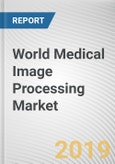Global medical imaging process market is segment based on the techniques into CT scan, X-ray, MRI, Ultrasound, nuclear imaging, and others. CT scan and X-ray technique segment hold the dominant share in the market. The availability of handheld X-ray devices and MRI scanners are fuelling the growth of global medical image processing market. Based on the image type, the market is segmented into 2D image, 3D image and 4D image. The introduction of 4D imaging have injected new momentum in the radiation therapy and it has also minimized the small tissue complications. The 4D imaging technology aims to track and compensate the target motion during radiation treatment and minimization of normal tissue injuries. The market is further segmented based on the application such as cardiology, gynaecology, breast mammography, neurology, oncology, autoimmune disease and others. Based on the geography, the market is segmented into North America, Europe, Asia-Pacific and LAMEA. North America holds the dominant share in the market owing to the early acceptance of the technology. Asia-Pacific is the fastest growing segment due to the increasing government initiatives in the healthcare industry. Moreover, the rising awareness of these techniques has been playing a key role in the growth of Asia-Pacific medical image processing market.
The key players of the market includes GE Healthcare, Philips Healthcare, Hitachi Medical Corporation, Hologic, Inc., Siemens Healthcare, Samsung Medison, Shimadzu Corporation, , and Toshiba Medical Systems Corporation.
KEY BENEFITS
Market analysis based on current market scenario and expected future trends to enable stakeholders take strategic decisions
Analysis of the factors impacting the market to understand business opportunities
Analysis of the market based on devices and geography as well as forecast from 2014 - 2021
Identification of key investment pockets for various applications, services and geographies
Identification of the key players and their strategic moves
Implications of the regulations and reimbursement scenario in diabetes care
Evaluation of market trends to provide deep-dive intelligence into every market segment
Competitive analysis to effectively plan and execute business plan
Micro level analysis based on application, service and geography
KEY MARKET SEGMENTS
The global medical image processing market is segmented into three major categories: application, technology, image type and geography.
BY APPLICATION
Cardiology
Gynecology
Breast mammography
Neurology
Oncology
Autoimmune disease
Others
MARKET BY TECHNOLOGY
CT-Scan
X-ray
Ultrasound
MRI
Nuclear Imaging
Others
MARKET BY IMAGE TYPE
2D
3D
4D
MARKET BY GEOGRAPHY
North America
Europe
Asia-Pacific
LAMEA
Methodology
The analyst offers exhaustive research and analysis based on a wide variety of factual inputs, which largely include interviews with industry participants, reliable statistics, and regional intelligence. The in-house industry experts play an instrumental role in designing analytic tools and models, tailored to the requirements of a particular industry segment. The primary research efforts include reaching out participants through mail, tele-conversations, referrals, professional networks, and face-to-face interactions.
They are also in professional corporate relations with various companies that allow them greater flexibility for reaching out to industry participants and commentators for interviews and discussions.
They also refer to a broad array of industry sources for their secondary research, which typically include; however, not limited to:
- Company SEC filings, annual reports, company websites, broker & financial reports, and investor presentations for competitive scenario and shape of the industry
- Scientific and technical writings for product information and related preemptions
- Regional government and statistical databases for macro analysis
- Authentic news articles and other related releases for market evaluation
- Internal and external proprietary databases, key market indicators, and relevant press releases for market estimates and forecast
Furthermore, the accuracy of the data will be analyzed and validated by conducting additional primaries with various industry experts and KOLs. They also provide robust post-sales support to clients.

LOADING...








